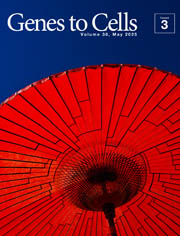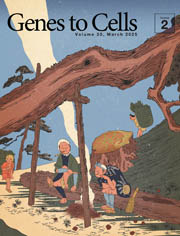
May 2025
How about a beautifully crafted Japanese umbrella featuring a circular phylogenetic tree, expertly handmade by skilled artisans, for your outings on rainy days? The phylogenetic tree was inspired by Figure 3 (phylogeny of Daidara, a gigantic transposon from Allacma fusca, and other Gypsy LTR retrotransposons) in Kojima (2023) Genes Cells 28: 746-752, DOI: 10.1111/gtc.13062.

March 2025
Two lumberjacks are resting against a tree stump. Each radial line visible on the stump represents a series of descendant cells derived from the same cambium stem cell in the vascular cambium. The cambium stem cells have the ability to differentiate into both xylem and phloem, playing a crucial role in the secondary growth (lateral growth) of plants. In cases where the stem cells were not labeled, the signal does not appear as continuous lines; instead, only the labeled, non-dividing differentiated cells are visible as isolated dots. We referred to the research of Dr. Dongbo Shi (RIKEN Center for Sustainable Resource Science).